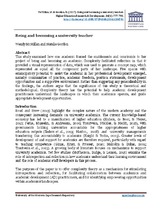| dc.contributor.author | McMillan, Wendy | |
| dc.contributor.author | Gordon, Natalie | |
| dc.date.accessioned | 2018-11-28T07:22:05Z | |
| dc.date.available | 2018-11-28T07:22:05Z | |
| dc.date.issued | 2016 | |
| dc.identifier.citation | McMillan, W. & Gordon, N. (2017). Being and becoming a university teacher. Higher Education Research & Development, 36(4): 777-790. | en_US |
| dc.identifier.issn | 0729-4360 | |
| dc.identifier.uri | http://dx.doi.org/10.1080/07294360.2016.1236781 | |
| dc.identifier.uri | http://hdl.handle.net/10566/4228 | |
| dc.description.abstract | This study examined how one academic framed the enablements and constraints to her project of being and becoming an academic. Complexity facilitated reflection in that it provided a visual representation of data, which was used to generate a concept map, which represented as equal all the component parts of her landscape. Five spaces with emancipatory potential to assist the academic in her professional development emerged, namely: communities of practice, academic freedom, position statements, development opportunities and a supportive environment. Rather than suggesting any generalisability in the findings, the authors argue that the significance of this study is theoretical and methodological. Complexity theory has the potential to help academic development practitioners understand the landscapes in which their academics operate, and guide appropriate development opportunities. | en_US |
| dc.language.iso | en | en_US |
| dc.publisher | Taylor & Francis | en_US |
| dc.rights | This is the post-print version of the article published online at: http://dx.doi.org/10.1080/07294360.2016.1236781 | |
| dc.subject | Academic development | en_US |
| dc.subject | Complexity | en_US |
| dc.subject | Constraints | en_US |
| dc.subject | Enablements | en_US |
| dc.subject | Teaching and learning | en_US |
| dc.title | Being and becoming a university teacher | en_US |
| dc.type | Article | en_US |
| dc.privacy.showsubmitter | FALSE | |
| dc.status.ispeerreviewed | TRUE | |

